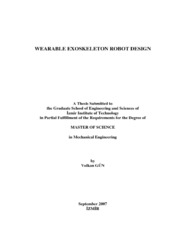Please use this identifier to cite or link to this item:
https://hdl.handle.net/11147/3838Full metadata record
| DC Field | Value | Language |
|---|---|---|
| dc.contributor.advisor | Keçeci, Emin Faruk | en |
| dc.contributor.author | Gün, Volkan | - |
| dc.date.accessioned | 2014-07-22T13:52:29Z | |
| dc.date.available | 2014-07-22T13:52:29Z | |
| dc.date.issued | 2007 | en |
| dc.identifier.uri | http://hdl.handle.net/11147/3838 | |
| dc.description | Thesis (Master)--Izmir Institute of Technology, Mechanical Engineering, Izmir, 2007 | en |
| dc.description | Includes bibliographical references (leaves: 81-82) | en |
| dc.description | Text in English; Abstract: Turkish and English | en |
| dc.description | xi, 94 leaves | en |
| dc.description.abstract | In this thesis study it is intended to design a wearable exoskeleton robot which will replace paralytic or disable people.s legs and provide to walk. The wearable exoskeleton robot will be an intelligent system that fulfill the gait necessities, climb the slopes up and down, and remove the disadvantages of the wheelchairs and mobility aid vehicles. Robot will be a wearable device like a trouser and it will work to carry out daily duties for users. Robot will increase user.s maneuver capabilities and support users. legs and aid walking action for users thanks to 3-one degree of freedom (DOF) joints which are designed for each leg and are powered by DC electric actuators. Design of the wearable exoskeleton robot includes, modeling and designing of the robot using a parametric solid modeling computer program (Solidworks), selection of the most suitable material for the design characters and robot manufacturing processes, strength analysis of the critical part of the robot, mathematical modeling of the system, design and manufacturing of the test machine and finding the most suitable walking combination by investigating degree of freedoms of each joints on the legs. In addition to mechanical design of the wearable exoskeleton robot, an electronic circuit is designed and manufactured in order to control each joint movement order and time in walking action. Moreover, in order to control the robot by the users, a keypad unit is manufactured on the robot and necessity functions are described in the program. As a result of this thesis; a wearable exoskeleton robot is manufactured to be used as a walking assistant. | en |
| dc.language.iso | en | en_US |
| dc.publisher | Izmir Institute of Technology | en |
| dc.publisher | Izmir Institute of Technology | en_US |
| dc.rights | info:eu-repo/semantics/openAccess | en_US |
| dc.subject.lcc | TJ211. G97 2007 | en |
| dc.subject.lcsh | Robots--Design and construction | en |
| dc.subject.lcsh | Mobile robots | en |
| dc.subject.lcsh | Robots--Kinematics | en |
| dc.subject.lcsh | Human-machine systems | en |
| dc.title | Wearable exoskeleton robot design | en_US |
| dc.type | Master Thesis | en_US |
| dc.institutionauthor | Gün, Volkan | - |
| dc.department | Thesis (Master)--İzmir Institute of Technology, Mechanical Engineering | en_US |
| dc.relation.publicationcategory | Tez | en_US |
| item.languageiso639-1 | en | - |
| item.fulltext | With Fulltext | - |
| item.openairecristype | http://purl.org/coar/resource_type/c_18cf | - |
| item.openairetype | Master Thesis | - |
| item.grantfulltext | open | - |
| item.cerifentitytype | Publications | - |
| Appears in Collections: | Master Degree / Yüksek Lisans Tezleri | |
Files in This Item:
| File | Description | Size | Format | |
|---|---|---|---|---|
| T000616.pdf | MasterThesis | 8.12 MB | Adobe PDF |  View/Open |
CORE Recommender
Page view(s)
26,638
checked on Jul 22, 2024
Download(s)
362
checked on Jul 22, 2024
Google ScholarTM
Check
Items in GCRIS Repository are protected by copyright, with all rights reserved, unless otherwise indicated.